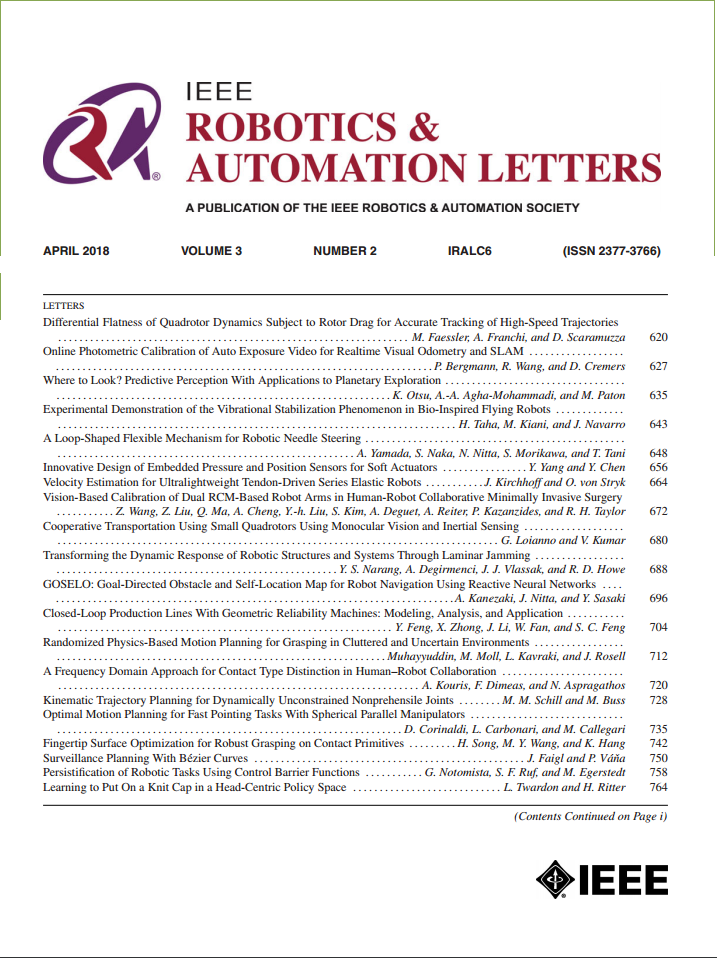sicnav -扩散:具有扩散轨迹预测的安全交互式人群导航
IF 5.3
2区 计算机科学
Q2 ROBOTICS
引用次数: 0
摘要
为了在人群中穿行而不发生碰撞,机器人必须通过预测人类未来的运动并做出相应的反应来与人类互动。虽然基于学习的预测模型在生成可能的人类轨迹预测方面取得了成功,但将这些随机模型集成到机器人控制器中存在一些挑战。控制器需要考虑计划的机器人运动和人类预测之间的交互耦合,同时确保预测和机器人动作都是安全的(即无碰撞)。为了解决这些问题,我们提出了一种适用于单机器人多人环境的后退地平线人群导航方法。我们首先提出了一个扩散模型来生成场景中所有人的联合轨迹预测。然后,我们将这些多模态预测合并到一个SICNav双层MPC问题中,该问题同时解决了机器人计划(上层),并作为安全过滤器来改进非碰撞预测(下层)。将规划和预测精化结合为一个双层问题,确保了机器人的规划和人类的预测是耦合的。我们在常用的ETH/UCY基准上验证了我们的扩散模型的开环轨迹预测性能,并在仿真和大量的真实机器人实验中评估了我们的机器人导航方法的闭环性能,证明了机器人运动的安全性、有效性和反应性。本文章由计算机程序翻译,如有差异,请以英文原文为准。
SICNav-Diffusion: Safe and Interactive Crowd Navigation With Diffusion Trajectory Predictions
To navigate crowds without collisions, robots must interact with humans by forecasting their future motion and reacting accordingly. While learning-based prediction models have shown success in generating likely human trajectory predictions, integrating these stochastic models into a robot controller presents several challenges. The controller needs to account for interactive coupling between planned robot motion and human predictions while ensuring both predictions and robot actions are safe (i.e. collision-free). To address these challenges, we present a receding horizon crowd navigation method for single-robot multi-human environments. We first propose a diffusion model to generate joint trajectory predictions for all humans in the scene. We then incorporate these multi-modal predictions into a SICNav Bilevel MPC problem that simultaneously solves for a robot plan (upper-level) and acts as a safety filter to refine the predictions for non-collision (lower-level). Combining planning and prediction refinement into one bilevel problem ensures that the robot plan and human predictions are coupled. We validate the open-loop trajectory prediction performance of our diffusion model on the commonly used ETH/UCY benchmark and evaluate the closed-loop performance of our robot navigation method in simulation and extensive real-robot experiments demonstrating safe, efficient, and reactive robot motion.
求助全文
通过发布文献求助,成功后即可免费获取论文全文。
去求助
来源期刊

IEEE Robotics and Automation Letters
Computer Science-Computer Science Applications
CiteScore
9.60
自引率
15.40%
发文量
1428
期刊介绍:
The scope of this journal is to publish peer-reviewed articles that provide a timely and concise account of innovative research ideas and application results, reporting significant theoretical findings and application case studies in areas of robotics and automation.
 求助内容:
求助内容: 应助结果提醒方式:
应助结果提醒方式:


